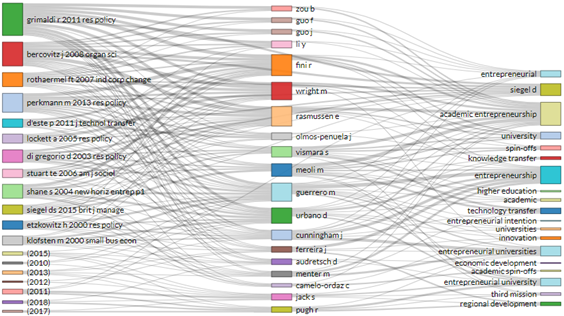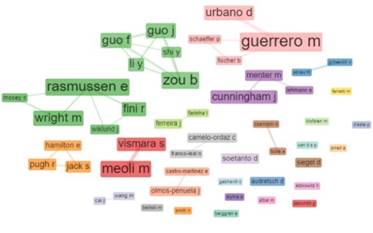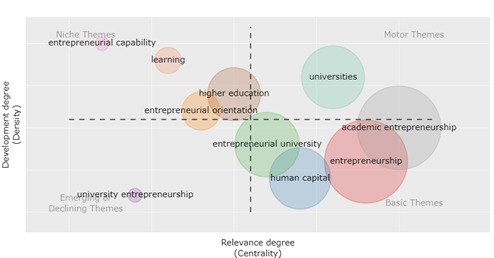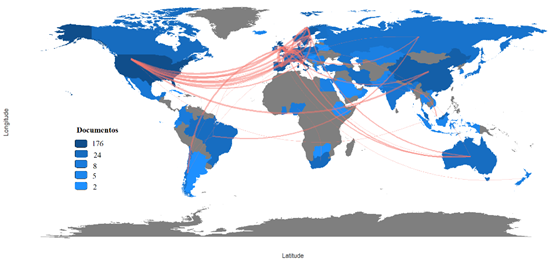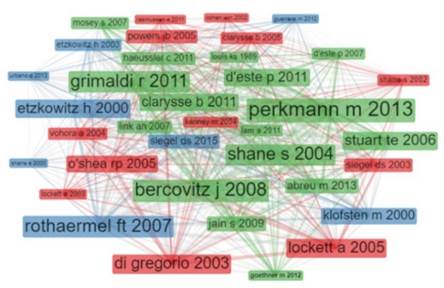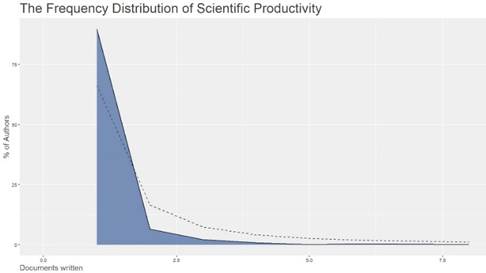Introduction
Lately, entrepreneurship has been constantly present in academic research. Several authors explore this theme by bringing conceptual and practical results, either specifically or complementary to other studies proposals (Markin et al., 2017; Skute, 2019; Phan Tan, 2021). From the traditional approach to those of hybrid character, the vast opportunities that arouse the interest of regional development researchers are notorious due to the generation of value, expressed in culture, knowledge and individual empowerment (Adelowo & Surujlal, 2020; Forliano et al., 2021; Sarango-Lalangui et al., 2018; Vera-Goméz et al., 2020).
Although various research approaches about entrepreneurship and regional development have been focusing on aspects like abilities, attitude and entrepreneurial intention; role, impact and stimulant points to the entrepreneurship; technological entrepreneurial universities formation; academic entrepreneurs presence and, transfer of knowledge and technology itself, rare exceptions address whether, this knowledge has an entrepreneurial character either in quality, dissemination; and measurement terms or into its proposals and implications (Brekke, 2020; Markin et al., 2017; Moreira et al., 2013; Skute, 2019).
Since we understand the need and the challenge of answering the gaps presented, the article proposes to measure the entrepreneurial nature of scientific knowledge by means Lotka's law (Guedes & Borschiver, 2005). Thus, we consider that the fundamental question permeates the scientific knowledge level on entrepreneurship in academic productions related to regional development.
Furthermore, the field explored has an interlinearity aspect aligned with emergent thematics, which are ‘knowledge’and‘entrepreneurship’, and this research aims to contribute to a different interpretation of traditional entrepreneurship, encouraging the use of bibliometrics tools for the evaluation of shared knowledge in scientific productions of regional development.
Academic Entrepreneurship and Regional Development
According Forliano et al. (2021), the innovative proposal on entrepreneurial universities was encouraged by studies in the 1990s that led to a new approach to entrepreneurship and it would not be limited to the business sphere, but would also penetrate the academic context. Because of systemic environment in formation, researchers has defended a field interaction to economic development for follow evolutions in this new context, in which has triggered an academic adaptive process (Sułkowski et al., 2019; Vekic et al., 2020).
In this way, the proposal of a third role aligned with the traditional responsibilities of universities - teaching and research - has become discussion point of new studies (Wagner et al., 2021). This feature connects to entrepreneurship that, as told by Siemieniuk (2016) and Vekic al. (2020), can be considered a source of economic multidimensional dynamism, capable of generate wealth, innovation and sustainable economic development. This ‘third mission’ argues that university has crucial keys to economic changes by knowledge creation, yielding economic growth (Kochetkov et al., 2017).
On Lyken-Segoseben et al. (2020) perspectives, the academic entrepreneurship can be regarded as strategic orientation, result of impacts provided by researches and its variety in knowledge. The activities that constitute this function concern the creation of revenues that adds to the institutions’ budgets, to the start up of new companies, and to their contribution to society’ development through knowledge production, dissemination, and commercialization.
Moreover, providing the effective dissemination of knowledge linked to academic proposes encourage universities on partnership prospection with stakeholders to a regional level (Brekke, 2020). In this process, the learning and proactivity are extremely relevant to strengthen the entrepreneurship ecosystem, expanding their regional development outlooks from the knowledge disseminated globally and, consequently, stimulating the formulation of political projects that propose changes in regional economies (Oliver et al., 2020; Pugh et al., 2021).
Nevertheless, Adelowo and Surujlal (2020), and Forliano et al. (2021) show concern about the immersion of this entrepreneurial ideology within scientific research. They explain discussions between careful authors that argue about the possibility of this path untwist the primary teaching and research purpose by research institutions. One of these reasons for that involve commercial gains potentials those other entrepreneurial activities could instigate on scientists and institutions, blocking university autonomy and liberty.
In contrast, there are researchers that defend a balance of this ‘third mission’ in learning and research. It can be generating value to the universities, society and government, and based on development (Zhang et al., 2016; Skute, 2019; Vera Goméz et al., 2019). Therefore, the need of empirical studies that approaches the scientific entrepreneurship benefits to as a whole development is crucial, especially with regard to the challenging emerging circumstances (Salomaa & Caputo, 2021).
Entrepreneurial Knowledge in Bibliometrics Light
From the standpoint of Zhang et al. (2016), the role played by knowledge has undergone significant changes since the genesis of endogenous growth model. In this context, their spillover influences externalities in favour of regional economic growth (Kochetkov et al., 2017; Vera-Gómez et al., 2019). Thus, Markin et al. (2017) understand the need of reviewing the contributions that researchers provide to develop new research agendas, evaluated on positioning, quality, and impact, in order to identify the main benefits of the studies themes for entrepreneurship and regional development.
Although the encouragement of innovation and entrepreneurship presents joviality in scientific productions, it is already a reality in academia if we take into account the requirement of originality in studies as a minimum degree of entrepreneurship. This culminates in the assertive speech of the authors Adelowo and Surujlal (2020) about the dependence of future works on the ability to implement new knowledge to solve humanity’s issues in a creative way. Therefore, this entrepreneurial nature of knowledge, disseminated through academic productions, can be deemed a synonym of productivity and competitiveness (Zhang et al., 2020).
Given the notorious importance of stimulating an entrepreneurial environment that promotes effective dissemination of knowledge on behalf of scientific development and solidity, Lotka’ law prospects understanding the entrepreneurial aspect of knowledge in scientific productions from the authors’ productivity (Guedes & Borschiver, 2005; Krüger et al., 2018). In brief, the bibliometric procedure measures knowledge externalized in research through qualitative and quantitative indicators (Gutiérrez-Salcedo et al., 2017).
This second law of Bibliometrics analyzes frequency of productivity from the authors in terms of the available academic productions. Taking into account the inverse square law to find the usefulness level of papers, the amount ‘n’ scientists producing ‘x’ papers equals ‘n/x’. Therefore, the smaller the result of this ratio is, the lower their productivity is (Alvarado, 2002; Guedes & Borschiver, 2005).
Methodology
To enable the study proposal, an innovative potential application of Lotka’s Law was identified, since the measurement of productivity per document and author could dialogue with the pre-existing scientific methodological parameters, bringing new reflections as to its use, impact and complementariness. In addition, two studies (Forliano et al., 2021; Gutiérrez-Salcedo et al., 2017) were chosen that approached some bibliometric methodological procedures differently for reliability and novelty of the data analyzed.
This procedure contemplates the following phases: establishing a guiding question that permeates the entire study, from the search in the databases to its final conclusion; conducting a scientific productions’ search of the chosen theme in the main databases, indexed and globally recognized; determining inclusion and exclusion criteria of the productions found, obtaining the desired amount without compromising the purpose of the study; analyzing the eligible articles within the research proposal, according to the initial selection criteria; and from the bibliometric review, clarifying the results obtained based on Lotka concomitantly to the complementary indicators chosen, the debate between authors, the conclusion captured, and the limitations in the production in question (Rodrigues et al., 2019).
We highlight some observations: firstly, the previous expressions academic entrepreneurship OR entrepreneurial universit* AND regional OR local development were included in the search fields without the quotation marks (“ ”), which was the most satisfactory option within the expectations of the study, once the desired results were not obtained when searching following the same patterns of the first base; secondly, these two bases were selected due to their relevance and academic recognition, as well as the high-quality volume of data available in journals refined by global scientific criticism; finally, all categories that did not include the objective to be reached were dismissed, such as the field of biological sciences and health.
Results and discussions
Bibliometric measurement
Respectively, in the Web of Science and Scopus databases, 12.342 and 801 documents were found. After filtering, the number of documents was reduced to 317 and 256. With the RStudio software (Aria & Cuccurullo, 2021; R Core Team, 2021), an integrated database was obtained with selected articles, removing duplicates and yielding 556 documents from 2012 and 2021 for the bibliometric analysis. These documents came from the production of 1364 authors from 864 institutions in 67 different countries.
Understanding the research that supported new studies among authors in the timeframe investigated reveals their interest in spreading knowledge, whether in a radical or incremental manner (see Figure 1).
Meanwhile, the Top-10 productions and their authors, ordered by citations/year’ number, were compiled in Table 1, as well as the Top-10 most relevant authors in documents’ quantity gathered in Table 2 below.
Table 1 Production ranking of authors per document according to the total citations
| # | Author | Year | Title | Total citations |
| 1 | SIEGEL D; WRIGHT M | 2015 | Academic Entrepreneurship Time for a Rethink | 227 |
| 2 | GUERRERO M; CUNNINGHAM J; URBANO D | 2015 | Economic Impact of Entrepreneurial Universities Activities: An Exploratory Study of the United Kingdom | 202 |
| 3 | ABREU M; GRINEVICH V | 2013 | The Nature of Academic Entrepreneurship in the UK: Widening The Focus on Entrepreneurial Activities | 197 |
| 4 | GUERRERO M; URBANO D; FAYOLLE A; KLOFSTEN M; MIAN S | 2016 | Entrepreneurial Universities Emerging Models in the New Social and Economic Landscape | 128 |
| 5 | RASMUSSEN E; MOSEY S; WRIGHT M | 2014 | The Influence of University Departments on the Evolution of Entrepreneurial Competences in Spin-off Ventures | 122 |
| 6 | GUERRERO M; URBANO D | 2013 | Academics Startups Intentions and Knowledge Filters: An Individual Perspective of The Knowledge Spillover Theory of Entrepreneurship | 78 |
| 7 | FINI R; RASMUSSEN E; SIEGEL D; WIKLUND J | 2018 | Rethinking the Commercialization of Public Science From Entrepreneurial Outcomes to Societal Impacts | 60 |
| 8 | COLOMBO M G; MEOLI M; VISMARA S | 2019 | Signaling in Science-based IPOS: The Combined Effect of Affiliation with Prestigious Universities Underwriters and Venture Capitalists | 46 |
| 9 | HEATON S; SIEGEL D; TEECE D | 2019 | Universities and Innovation Ecosystems: A Dynamic Capabilities Perspective | 32 |
| 10 | CUNNINGHAM J; MENTER M | 2020 | Transformative Change in Higher Education: Entrepreneurial Universities and High technology Entrepreneurship | 10 |
Source: Aria and Cuccurullo, 2021
Table 2 The top 10 of most relevant authors according to the quantity produced
| # | Author | H-Index | Total citations | Documents | Year |
| 1 | MEOLI M | 7 | 221 | 8 | 2013 |
| 2 | WRIGHT M | 6 | 491 | 6 | 2012 |
| 3 | VISMARA S | 6 | 181 | 6 | 2013 |
| 4 | GUERRERO M | 5 | 429 | 8 | 2013 |
| 5 | URBANO D | 5 | 428 | 6 | 2013 |
| 6 | RASMUSSEN E | 5 | 300 | 6 | 2014 |
| 7 | FINI R | 5 | 116 | 6 | 2016 |
| 8 | CUNNINGHAM J | 4 | 243 | 6 | 2015 |
| 9 | SIEGEL D | 4 | 356 | 4 | 2015 |
| 10 | OLMOS-PENUELA J | 4 | 121 | 4 | 2014 |
Source. Aria and Cuccurullo, 2021
The social aspect of bibliometric composition explain the interaction between studies and their authors takes place (Figure 2) confirms Forliano et al. (2021) perspective, in which a large number of the relevant researchers act in a restricted way in their circles, and there are still other isolated ones who could broaden their exploratory horizons.
The same authors (Forliano et al., 2021) explain that the amount of papers by a researcher determines the node size and, at the same time, the amount of co-authorship between close researchers constitutes studied fields and their interaction. In this map (Figure 3), one can identify the research field in which these authors cooperate through clusters distinguished by colours, generating value in the network co-occurrence.
Furthermore, the world collaboration map (Figure 4) shows nations’ academic productivity, as well as research collaborations. In fact, the most productive countries are also the most economically developed, implying higher levels of research collaboration.
Finally, the intellectual sphere comprises, from the perspective of Gutiérrez-Salcedo et al. (2017), a co-citation network analysis between documents (see Figure 5) and suggests that, although authors in red cluster appear to have a weaker connection - represented by a single line between them, references of all clusters are strongly correlated in the literature.
The second bibliometric law, Lotka, plays a key role in the analysis of the entrepreneurship character of academic productions, since it measures the frequency of authors’ productivity through scientific documents in a period, in terms of proportionality (see Figure 6); and Table 3 presents details on the proportion of authors who collaborated in the publications.
An interesting fact occurs in the distribution of the grouping of authors with five, six and eight documents. This singular configuration differs from the pattern proposed by the inverse square law, highlighting the importance of studying this phenomenon more thoroughly (Guedes & Borschiver, 2005). Thus, the proportional order of articles in terms of contribution would be, respectively, 6 (2.26%), 8 (1%) and 5 (0.31%).
Table 3 Productivity frequency according Lotka
| Documents(X) | Quantity of authors (Y) | Proportion of authors (% Y) | Number of articles (X . Y) | Proportion of articles (% X . Y) |
|---|---|---|---|---|
| 1 | 1225 | 89,81% | 1225 | 76,85% |
| 2 | 89 | 6,52% | 178 | 11,17% |
| 3 | 30 | 2,20% | 90 | 5,65% |
| 4 | 11 | 0,81% | 44 | 2,76% |
| 5 | 1 | 0,07% | 5 | 0,31% |
| 6 | 6 | 0,44% | 36 | 2,26% |
| 8 | 2 | 0,15% | 16 | 1,00% |
| TOTAL | 1364 | 100 | 1594 | 100 |
Source. Adapted from Moreira et al. (2013) and Aria and Cuccurullo (2021)
Lotka distribution
Taking account Lotka analyses the authors’ productivity based on the number of documents produced in descending order, it was possible to establish a correlation between the results of Table 2 and the H-index. Like Lotka’s law, this indicator measures productivity, however, based only on citations accumulated by the documents over time (see Table 4).
Table 4 Crossing Lotka and H-index indicators
| Author | Lotka (%) | Documents | H-Index | Total citations | Year |
| ZOU B | 4,00 | 5 | 2 | 17 | 2019 |
| CUNNINGHAM J | 2,78 | 6 | 4 | 243 | 2015 |
| URBANO D | 2,78 | 6 | 5 | 428 | 2013 |
| RASMUSSEN E | 2,78 | 6 | 5 | 300 | 2014 |
| FINI R | 2,78 | 6 | 5 | 116 | 2016 |
| WRIGHT M | 2,78 | 6 | 6 | 491 | 2012 |
| VISMARA S | 2,78 | 6 | 6 | 181 | 2013 |
| GUERRERO M | 1,56 | 8 | 5 | 429 | 2013 |
| MEOLI M | 1,56 | 8 | 7 | 221 | 2013 |
Source. Aria and Cuccurullo (2021)
Observing the data, it is evident that they are from distinct scopes to analyse the entrepreneurial character of the publications. The first author Zou B has five published documents. Applying the inverse square law, this researcher has better productivity per study than others. However, this differs in the H-index. Taking into account the productions of this author according to the total number of citations, we can conclude that his productivity does not seem to be significant enough for other researchers within the same theme.
However, when applying Lotka’s concept to the last author - Meoli M, his productivity level is slightly higher than the first one. He has a higher number of total citations and greater representativeness within the scientific context according to the H-index. This reality, by the way, is not confirmed from the second bibliometric law standpoint, because the greater the number of articles produced, the lower the author’s productivity. Therefore, questions emerge about the productivity concept in these two cases and how it is measured in methodological terms, in addiction to reflecting on the data alignment in both cases from Lotka’s perspective, as proposed Alvarado (2002).
Hence, it is crucial to understand the nature of these indicators to measure the entrepreneurial degree of knowledge in scientific productions, since the perspectives of productivity and relevance are distinct and not necessarily complementary. This is because, from the previous table analysis (Table 3), authors who have fewer publications may have higher frequencies according to Lotka, but this feature is not absolute in the crossing with the H-index.
Measuring entrepreneurial character from other bibliometric tools
In this differentiated scenario, it is crucial to investigate how Lotka’s law can evaluate the productivity of scientific productions, with entrepreneurial character of knowledge as its main relevance indicator in addition to existing quantitative data. Therefore, we propose to analyze the entrepreneurial level of publications based on documents, highlighting other bibliometric tools to compose the analysis in hand.
For instance, the three-field graph (Figure 1) brigs two interesting aspects. The first deals with the amount of authors who referenced previous works, considered extremely important for their research, while the second point reflects on the significance of current documents for new studies, expanding knowledge of an entrepreneurial nature. Such aspects are assertive as to the multidisciplinary broadening of the entrepreneurship field, being crucial for emerging study proposals (Adelowo & Surujlal, 2020; Forliano et al., 2021).
Thus, under the three-field graphic view (Figure 1), the most relevant productions reclassification (Table 1) upon the subsequent productions was proposed in Table 5. Differently from the first scenario, certain publications that had great representativeness in terms of citations set themselves up in new positions owing to new studies originated after their proposals.
In this updated table of the first publication case, for example, it somehow influenced the formulation of 52 new researches, despite being in 3rd place in Table 1. Meanwhile, the second position authors in this new framework have fostered 50 subsequent documents, even though they are in 1st place in the other perspective.
Table 5 Main production ranking according to the amount of subsequent documents
| RANK | MAIN PUBLICATIONS | SUBSEQUENT DOCUMENTS | ||
| # | Author | Year | Title | Total citations |
| 1 | ABREU M; GRINEVICH V | 2013 | The Nature of Academic Entrepreneurship in the UK: Widening The Focus on Entrepreneurial Activities | 52 |
| 2 | SIEGEL D; WRIGHT M | 2015 | Academic Entrepreneurship Time for a Rethink | 50 |
| 3 | RASMUSSEN E; MOSEY S; WRIGHT M | 2014 | The Influence of University Departments on the Evolution of Entrepreneurial Competences in Spin-off Ventures | 23 |
| 4 | GUERRERO M; CUNNINGHAM J; URBANO D | 2015 | Economic Impact of Entrepreneurial Universities Activities: An Exploratory Study of the United Kingdom | 16 |
| 5 | GUERRERO M; URBANO D | 2013 | Academics Startups Intentions and Knowledge Filters: An Individual Perspective of The Knowledge Spillover Theory of Entrepreneurship | 16 |
| 6 | FINI R; RASMUSSEN E; SIEGEL D; WIKLUND J | 2018 | Rethinking the Commercialization of Public Science From Entrepreneurial Outcomes to Societal Impacts | 12 |
| 7 | GUERRERO M; URBANO D; FAYOLLE A; KLOFSTEN M; MIAN S | 2016 | Entrepreneurial Universities Emerging Models in the New Social and Economic Landscape | 11 |
| 8 | COLOMBO M; MEOLI M; VISMARA S | 2019 | Signaling in Science-based IPOS: The Combined Effect of Affiliation with Prestigious Universities Underwriters and Venture Capitalists | 1 |
| 9 | HEATON S; SIEGEL D; TEECE D | 2019 | Universities and Innovation Ecosystems: A Dynamic Capabilities Perspective | 1 |
| 10 | CUNNINGHAM J; MENTER M | 2020 | Transformative Change in Higher Education: Entrepreneurial Universities and High technology Entrepreneurship | 1 |
Source. Own elaboration
Among the main productions list, we sought to verify which subsequent publications were based on the previous ones or that referenced these. From that, Figure 7 of letters from ‘a’ to ‘f’ was developed to clarify this reflection, reinforcing the relevance of using multiple methodological procedures to build a structurally robust framework of knowledge.
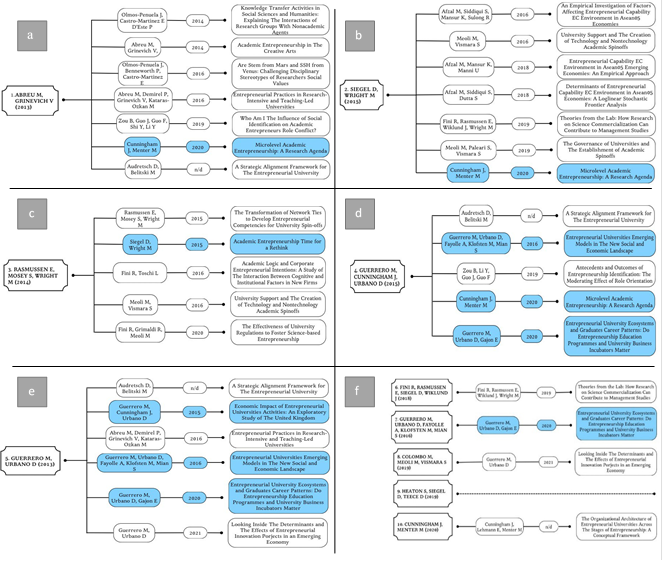
Figure 7 Diagram 1 to 10 of subsequent documents quoted afterwards according Table 5, a). Diagram 1, b). Diagram 2, c). Diagram 3, d). Diagram 4, e). Diagram 5, f). Diagram 6 to 10
Regarding the subsequent articles that referenced their predecessors, those representing positions 3, 4 and 5 were instruments to think about new approaches in posterior publications of this nature, identified by the blue color. In other words, the articles highlighted duly used the knowledge exposed in the previous documents to elaborate new proposals or increment perspectives.
This shows that the connections density between authors in figure 5 presents changing for a new phase of studies, since these authors are mentioning different researchers from their own co-authors field and, at the same time, being partially selective to the most relevant authors group for the literature.
Table 6 shows how this classification proceeded. These studies, according to the bibliometric data, brought issues of innovative character, emphasizing the knowledge inherent to regional development and aligned to academic entrepreneurship.
Such issues focused on the authors interaction and its importance for the development are highlighted within the research of Brekke (2020) and Wagner et al. (2019), about the third mission as a tool for systemic resolutions, stressing the relevance of the dissemination and diversification of knowledge for the regional development, expressed by other studies (Kochetkov et al., 2017; Siemieniuk, 2016; Vekic et al., 2020).
In this sense, the issue raised by Markin et al. (2017), regarding the scarce amount of research that measures the entrepreneurial character of knowledge is valid. Although there is a broad theoretical framework of academic entrepreneurship and inherent to knowledge transfer, its majority is limited to technical, conceptual and technology-oriented aspects, which is also align with the proposals of Skute (2019) and Vera-Goméz et al. (2020) previously explained.
Table 6 Classification by constructs and attributes of the most relevant publications according to bibliometric data
| CONSTRUCTS | ATTRIBUTES | Siegel, D; Wright, M (2015) | Guerrero, M; Cunningham, J; Urbano, D (2015) | Abreu, M; Grinevich, V (2013) | Guerrero, M; Urbano, D; Fayolle, A; Klofsten, M; Mian, S (2016) | Rasmussen, E; Mosey, S; Wright, M (2014) | Guerrero, M; Urbano, D (2013) | Fini, R; Rasmussen, E; Siegel, D; Wiklund, J (2018) | Colombo, M; Meoli, M; Vismara, S (2019) | Heaton, S; Siegel, D; Teece, D (2019) | Cunningham, J; Menter, M (2020) | TOTAL | |
|---|---|---|---|---|---|---|---|---|---|---|---|---|---|
| Academic entrepreneurship | 1 | Technology transfer | x | x | x | x | x | 5 | |||||
| 2 | Academic spin-offs | x | x | x | 3 | ||||||||
| 3 | Knowledge | x | x | x | x | 4 | |||||||
| Entrepreneurship | 1 | Innovation | x | x | x | x | x | 5 | |||||
| 2 | Regional development | x | x | x | x | x | x | 6 | |||||
| 3 | Collaboration | x | x | x | 3 | ||||||||
| Entrepreneurial universities | 1 | Third mission | x | x | x | x | 4 | ||||||
| 2 | Triple Helix | x | x | x | x | 4 | |||||||
| University | 1 | Higher Education | x | x | 2 | ||||||||
| 2 | Entrepreneurial | x | x | x | x | x | 5 | ||||||
| Social Capital | 1 | Social enterprises | 0 | ||||||||||
| 2 | Social entrepreneurship | 0 | |||||||||||
Source: The authors
Siegel and Wright (2015) emphasize the need to remodel the perspective of academic entrepreneurship, since a large number of studies have given attention exclusively to the points inherent to the third mission of entrepreneurship universities, such as commercialization and technology transfer. Among the model proposed to explore the changes of this third mission, the authors highlight the need for a more conscious and balanced view of universities when monitoring the systemic environment, along with teaching and research. They also identified that collaborative actions integrated with industry, incubators and business accelerators influence the labour mobility of individuals, bringing positive impacts for regional development.
Such proposition is in agreement with Sułkowski et al. (2019), Vekic et al. (2020) and Forliano et al. (2021) on the importance of adaptation for survival in the systemic environment, as well as complements the idea of Oliver et al. (2020) and Pugh et al. (2021) on the significance of learning and proactivity in this process.
Abreu and Grinevich (2013) aimed, through the academic respondents’ analysis, to understand the determinants of academic engagement on its range of activities. They concluded that researched universities significantly contributed with teaching, research and entrepreneurial activities, primarily in as much as the spin-offs creation and knowledge transfer is concerned.
Likewise, Guerrero et al. (2015) identified the importance of academic entrepreneurship in intellectual property and knowledge transfer actions, examining how this entrepreneurship might be appropriately measured and how multidimensional studies may assist in this process. Furthermore, Rasmussen et al. (2014), reiterate that it is vital to understand the structuring and department levels of spin-off universities to properly foster them in the face of challenges of transitioning skills from social capital to commercialisation of innovations.
On the same line, Heaton et al. (2019) explain that universities have an essential role to the innovation ecosystems, whose models linked to the triple helix enable a maturation scenario for the interactions between academia, industry and government in benefit of economic development. Thus, understanding entrepreneurial management and its flexibility in the systemic context become fundamental to improve this environment’s life cycle.
Such facts appear in the studies of Adelowo and Surijlal (2020) and Vera-Goméz et al. (2021) on value generation for development processes through general knowledge, corroboration with new actions at social, economic and governmental levels beyond universities boundaries.
Guerrero and Urbano (2013) already wrote about entrepreneurship as a driving toll for knowledge transfer, highlighting the relevance of entrepreneurial intentions role in the companies’ creation and the knowledge filtering in its transfer process in the university sphere. Considering the theories of knowledge expansion and planned behaviour, the authors proposed a model that explained the action of these intentions in the dissemination of this knowledge, concluding that some motivational aspects arising from collective constructs influence and, at the same time, are stimulants of the development from the sense of identity and social interaction.
Guerrero et al. (2016) complement that there is a growth of countries those adopt public policies to promote innovation through entrepreneurial institutions, promoting regional development with initiatives of technological nature. The authors point out universities are like innovation and entrepreneurship vectors, supporting the creation and strengthening of an integrated ecosystem that provides impact at educational, research and knowledge transfer levels. Furthermore, they propose through methodological frameworks issues resolution concerning the theme, in addition to provoking new implications derived from such direction.
Fini et al. (2018) clarified aspects inherent to the third mission considering the scientific commercialization of knowledge, which provides broad social impacts on development with instrumentality in innovation. Colombo et al. (2019) also address innovative issues in the interaction between prestigious actors linked to universities, underwriters and capitalist companies in the biotechnology sector, emphasizing how the strengthening of interactions takes place in this context.
Finally, the research of Cunningham and Menter (2020) pointed out the high technology field, aiming at understanding the influence of higher education policies on regional development, from a change in the universities’ orientation to the entrepreneurial perspective. They observed that industry integration level and overarching scientific approach of universities provide significantly positive impacts for regional entrepreneurship, influencing decision making.
Conclusions
In this article, we propose to measure the entrepreneurial nature of scientific knowledge using the second bibliometric law, applied to the context of regional development. Due to comparisons found, it was concluded primarily that Lotka’s law is capable of measuring value in terms of production quality rather than quantity produced, since its approach highlight the most relevance of well-structured and impactful unitary production - with collaboration or not - applied to different contexts than a collection of productions with little conceptual variation and circumstantial applicability.
However, the prior visible lack of intersection between this indicators denoted that this indicator shoud not be considered in isolation form to measure the entrepreneurship level of scientific knowledge, since when applied in this way, this test-measurement instrument does not have sufficiently convincing contribution to reliably synthesize a concept of multiple complex variables, presented in qualitative analysis. This is considered a major boundary to be overcome.
In an endeavor to transcend this limit, a qualitative analysis of the most important productions was carried out as a descriptive tool of the reability of the indicators. In this regard, it was found that these publications contributed to the effective and creative dissemination of “entrepreneurial nature of knowledge”, concerning emerging issues from a holistic and critical viewpoint to the regional development context linked to academic entrepreneurship. Furthermore, the majority of these productions touched on in-depth reflections on knowledge as a tool for entrepreneurial differentiation for journals, universities and research, emphasizing aspects pertinent to the social impacts and development of a given region.
However, in spite of the efforts made to achieve the research objective, some barries were identified. With regard to the indicators intersection, a more refined conceptualization of productivity is suggested for the Lotka and H-index, aligned with “entrepreneurial character of scientific knowledge” definition. This could enable new methodological reflections, providing them with greater clarity within academia, despite their complexity.
Another limitation is the abstration of the proposed concept of “entrepreneurial nature of scientific knowledge”. Thus, even though the selected studies have made interesting dialogical contributions, there are still rare and scarce examples that bring or adapt an approach distinct from the traditional perspective of entrepreneurship (i.e. business field) into the regional development sphere. In addiction, there is a current complexity in the treatment and perception of the variables inherent in “entrepreneurial knowledge”, since new sets of methodological tools are not being tried out to ascertain the interference level of the variables in the proposed concept and in its regional applicability.
Given these barriers, it is imperative for new studies to use more robust and effective appropriation methods that provide solid results concerning projects of regional impact whereas little clarification on the construction of a consistent definition for ‘entrepreneurial knowledge’ - third reason. This could corroborate to the dialog between studies and author collaborations in persistent patterns of bibliometric co-occurences and networks.
Another viable proposal for new publications consists of studying the causality relations with regard to the interrelations between authors-content-publications through multi-criteria models, contributing to the estimating process an average level of entrepreneurial knowledge in order to understand its behavior in a globalized way in scientific productions.
Furthermore, another interesting implication could be comparisons between the main existing indicators in the literature and this new indicator proposal, presenting the differentiations among them and their justifications for the use and analysis. It is worth mentioning that our understanding of a proposal for new indicators is not intended to replace traditional indexes, but suggesting a complementarity to the analysis of scientific productions.
To overcome the limitations encountered, it is important to include other databases such as Scielo, Sciencedirect, Google Scholar, CAPES journals and sciences.gov; not only to obtain more regionalized studies of complementary bases, but also to broaden the analysis of the entrepreneurship perception in scientific production so as to structure a coherent proposal that is consistent with the traditional semantics of the terminology applied to scientific knowledge.














